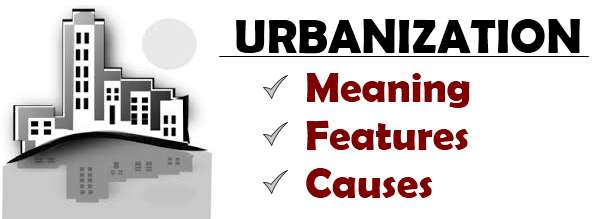Urbanization | Meaning | Features | Causes of rapid urbanization in India

What is Urbanization?
The term urbanization denotes an increase in the urban population at a rate higher than that of the increase in the rural population. Urbanization happens in any of the following ways:
- Natural increase in population in urban areas, and
- Migration of people from rural areas to urban areas.
Of the two, the second way of urbanization is considered as the chief reason for urbanization all over the world.
Despite the rural nature of the Indian economy, there has been a shift in the trend towards urbanization. The growth of urban population has been very large since 1961 and particularly so since 1971. Some consider it nothing short of an urban-explosion.
Features of Urbanization
The important features of urbanization are as follows:
1. Fast Growth in Urban Population: Between 1961-71 the growth rate of population in urban areas was over 38%. This was followed by a still higher growth of 46 per cent during the decade of 1971-81. Between 1981-91, the growth was, no doubt, somewhat less at over 36 per cent but it was not inconsiderable.
2. Large Increase in big owns: Another noteworthy feature of urbanization is that there has been a substantial increase in the population of big towns. A substantial increase in population has taken place since 1901 in the big towns, and that a major proportion of urban population resides in them.
3. Regional Disparities in Urbanization: The above description provides the all-India picture. However, the variations in the level of urbanization in various states are indeed large and rates of urbanization show surprises. Again, there are variations within the regions of each state. All this point to the diversity of conditions/causes that operate in this vast country, and is suggestive of different perceptions and policies in this field.
Causes of Rapid Urbanization
The rapid urbanization is the outcome of three important factors.
They are:
- natural population increase,
- migrations, and;
- boundary changes.
1. Natural Increase in Population: One important cause of rapid urbanization is the natural increase in population. The number by which the birth rate exceeds the death rate in urban areas gives.this. This is probably higher than the rural. The net survival rate is also higher on account of the availability of the health and medical facilities.
2. Migrations from Rural Areas: Migrations from rural areas is another factor responsible for rapid urbanization. At the moment their number is not exactly known. But it can be guessed that it may be something to do with the swelling of urban population. The rural to urban migrations have been caused by several factors in the past since Independence.
Industrial development has, for example, led to creation of many activities of manufacturing, trading etc. attracting rural people seeking jobs, higher incomes etc. Backwardness of the villages in respect of living conditions is another factor pushing people out of the villages. The availability of many opportunities for good education and living in urban areas etc. have also attracted rural people to the urban areas.
3. Boundary Changes: As cities expanded, the outlaying rural areas have been included in the urban areas. They may even continue to retain most of the characteristics of villages. But they.are counted as urban population by virtue of being classified as urban areas. Population falling in these areas also swells the number of urban population.
